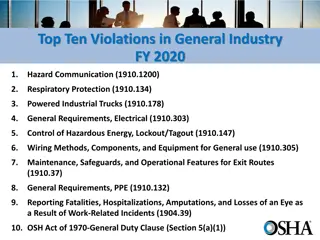Comprehensive Guide to Lockout/Tagout Procedures in Industries
Lockout/Tagout (LOTO) procedures are essential for ensuring safety in industries and laboratories by preventing accidental start-ups of equipment. This guide covers the importance of LOTO, examples of LOTO devices, when to use LOTO, and steps to properly implement LOTO procedures. It also highlights OSHA standards and regulations to protect employees from hazardous energy sources during maintenance and servicing activities.
Download Presentation

Please find below an Image/Link to download the presentation.
The content on the website is provided AS IS for your information and personal use only. It may not be sold, licensed, or shared on other websites without obtaining consent from the author. Download presentation by click this link. If you encounter any issues during the download, it is possible that the publisher has removed the file from their server.
E N D
Presentation Transcript
Lockout/Tagout Title 29 Code of Federal Regulations (CFR) Part 1910.147
Objectives of Training Agenda 1. 4. Corrective measures to mitigate hazards. What is Lockout/Tag out? 2. Lockout/Tag out Standards. 5. Examples of correct and incorrect Lockout/Tag out. 3. Typical Common issues of Lockout/Tag out. 6. Case Study.
What is Lockout/Tag out? Lockout Tag out (LOTO) is a safety procedure used in industries and laboratories to lock and tag equipment from accidental start up. LOTO is only required for equipment that are capable of releasing hazardous energy and when performing electrical service. This hazardous energy can be in the form of electricity, mechanical energy, chemical energy, pneumatic energy or gravitational potential energy. It is also performed on equipment that is under maintenance.
When Should LOTO be Used? Maintenance Installing parts or machine Install electrical components or service electrical parts. Inspecting machines Trouble-shooting Adjusting Cleaning Unjamming
How to use LOTO 1. Notify affected employees. 2. Power off equipment. 3. De-energize equipment from power source. 4. Apply appropriate LOTO devices including, but not limited to locks and tags. 5. Dissipate any stored energy. 6. Double-check energy isolation is complete by attempting to start machine 7. Return all controls to neutral position after testing.
OSHA Standards Standard establishes the employer's responsibility to protect employees from hazardous energy sources on machines during service or maintenance Instate an energy control plan suited to the type of machines and workplace Done by use of LOTO equipment on equipment using the prescribed outline given via the OSHA standard The Control of Hazardous Energy (Lockout/tagout) Title 29 Code of Federal Regulations (CFR) Part 1910.147 Electrical: 29 CFR 1910.33
Typical Common issues/and How to Mitigate the Hazards Typical Common Issues How to Mitigate the Hazard 1. Ensure all employees are trained for LOTO and are aware of LOTO procedures and when they will occur. Tags must be thoroughly filled out and must accurately depict the reason for locking. Each employee servicing the equipment must use their own lock and tag. Locks must be used appropriately, not for personal use. 1. Lack of procedures/training all employees. 2. Wrong use of tags. Wrong use of locks. 2. 3. Working under someone else's lock. 4. Locks must be used appropriately. 3. 4.
Typical Common issues/and How to Mitigate the Hazards Cont. Typical Common Issues How to Mitigate the Hazard 5. 6. 7. Not identifying all energy sources. Annual audit of procedures. Maintenance vs. Minor routine tool changes. Duplicate keys. 5. Provide safety checklist to employees to ensure all energy sources are controlled. Annual audit determines if all energy sources have been identified and employees have knowledge of them. Know difference between maintenance and minor routine adjustments. Never duplicate keys. Break and dispose of any duplicate keys. 6. 8. 7. 8.
Case Study A printing press produces printed materials as its normal production function. The printing press's rollers have to be cleaned periodically during the work shift to ensure quality control. In this scenario, the press is not shut down for the cleaning operation. The printing press is energized and its rollers continue to spin at a very high speed. In order for employees to clean the rollers they must bypass the printing press's machine guards, and use rags to clean the rollers. This exposes them to serious, ingoing nip point hazards created by the rollers. Severe laceration or amputated fingers could result if the rag or an employee's hand were to get caught in the rollers or in an area between the rollers and a fixed part of the machine. Although the employer has a lockout/tagout program for servicing and/or maintenance of the printing presses, for this particular cleaning operation the employer believes that lockout/tagout procedures do not need to be implemented. According to the employer, this cleaning operation is exempt from lockout/tagout requirements because it falls under the minor servicing exemption and therefore the employer allows the equipment to remain operating during the cleaning operation.
Case Study Question 1 Is this printing press roll cleaning activity covered by the Lockout/Tagout standard? Yes or No Refer To OSHA: (29 CFR 1910.147)
Case Study Question 2 The employer argues that the roll cleaning activity is routine, repetitive, and integral to the production operation and that lockout is not required because the minor servicing exception described in 29 CFR 1910.147(a)(2)(ii) is applicable. Is the employer correct? Yes or No Refer to OSHA code: (Subpart O of 29 CFR 1910) (29 CFR )1910.147
References Dalto, J. (2019, October 31). LOTO Safety: The 6 Steps of Lockout/Tagout. Retrieved November 20, 2019, from https://www.convergencetraining.com/blog/loto-safety-6-steps-of- lockout-tagout Safety Talk, LOTO Authorized Employees. Retrieved from http://www.colby.edu/humanresources/wp-content/uploads/sites/170/2015/05/LOTO- Authorized-Safety-Talk.pdf (2018) Electrical Lockout Devices [Photograph]. Retrieved from https://www.slideshare.net/complianceandsafety/lockout-tagout-by-ctdol The 10 most common problems with lockout/tagout. (2019, June 25). Retrieved November 20, 2019, from https://www.ishn.com/articles/84043-the-10-most-common-problems-with- lockout-tagout Devil, Van. (2017 November 20) Incredible Accident of Missing Lockout Tag out. Retrieved from. https://www.youtube.com/watch?time_continue=1&v=IeACvAKKM_4&feature=emb_title Lockout Tagout (loto) Procedure. (2016 September 26). Retrieved from. https://www.youtube.com/watch?v=rNEbC7bPyxM OSHA Fact Sheet Lockout/Tagout (2002) [Web PDF]. Retrieved from https://www.osha.gov/OshDoc/data_General_Facts/factsheet-lockout-tagout.pdf










































